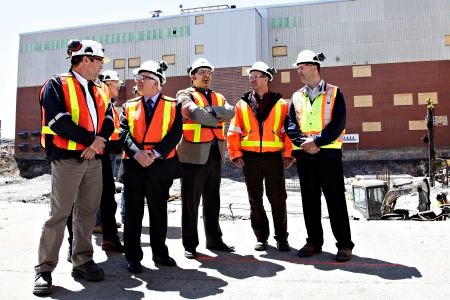Five years after Inco was purchased by Brazilian mining giant Vale, the company is pouring unprecedented levels of capital into its operations across Canada, with the North poised to reap a share of the benefits.
In November 2010, Vale announced it would be embarking on a $10-billion investment program across the country over the next five years, with a third of that going into its Sudbury operations.
“For Sudbury, $3.4 billion has been targeted over the next few years,” said Angie Robson, manager of corporate affairs for Ontario operations at Vale. “It certainly speaks to Vale’s commitment to Sudbury and the fact that we certainly have a long future of mining here.”
Dick DeStefano, executive director of the Sudbury Area Mining Supply and Services Association (SAMSSA), said the promise of spilloff from the Vale investment is unique because that amount of capital from a company has never been concentrated in such a short period of time.
DeStefano said there has not been much downtime—with the exception of the year-long Vale strike in 2010—for SAMSSA members.
“The industry is feeding itself almost,” he said. “The company wants to mine and they can’t mine without a refinery and a mill; they need to extract ore, they need equipment to do that, the equipment needs to be maintained, the equipment needs to be new, and we need new technologies so we can get it out faster.”
Vale’s Challenging Ore Recovery (CORe) project is a $200-million project designed to increase nickel recoveries at Clarabelle Mill and includes the construction of a new floatation plant and a new dry/change house for employees. Construction began last March and the floatation plant is expected to be done by July, while modifications to the existing mill should be done by June 2013.
“It’s significant because it maximizes the value of the resource in the ground and it also increases the resource base that we have to choose from,” Robson said. “It makes ore, that maybe was not previously economic to mine, now economical.”
At the peak of construction, the project will create between 150 and 200 construction jobs. That there is such a sophisticated mining supply and service sector in Sudbury is a strategic advantage for Vale, Robson said, and, as with all Vale’s projects, the company will aim to hire as many local firms as possible to complete the work.
“Definitely the local supply and service sector is working on projects as we speak, and will continue to work on projects as we move forward,” she said.
The most significant investment will go into the Atmosphere Emissions Reduction (AER) project, scheduled to be complete by 2015. Between $1.5 and $3 billion will go into technology designed to reduce sulphur dioxide emissions from plant operations by 70 per cent of current levels.
The current regulatory limit for suphur dioxide emissions is 66 kilotonnes per year; Vale expects to be at 45 kilotonnes per year when the AER project comes online.
“Government regulations are continuing to get more challenging,” Robson said. “They’ll probably continue to get more challenging as we move into the future, and the feasibility study that we conducted showed that the technology we’re implementing is allowing us to do even better, so why not do it now while we can?”
At the peak of construction, the company will need 1,300 additional workers, many of which Robson expects will come from the local service and supply sector, although she concedes that the project will require the company to look across the province for expertise.
It’s a sticking point for DeStefano that there will be outside firms getting the business, but he acknowledges that there is plenty of work for Northerners. Many companies are so busy they can’t keep up with demand and they have to order equipment a year ahead of when they need it just to meet tight schedules.
“We’re good for five years,” DeStefano predicted.
To more accurately determine the gain to the city, Vale plans to conduct an economic benefit and impact study, since the company anticipates the ripple effect to reach to the retail and hospitality sectors and beyond, “just because of the sheer size of the project,” Robson said.
The Totten Mine—which will be the company’s first mine built in Sudbury in 40 years—is still in the construction phase, but its completion is anticipated for the end of 2013. When in operation, it will employ 130 people.
Capital of $130 million will be invested into the project, located west of Sudbury near Worthington, and has an expected lifespan of 20 years. It will create 100 jobs and be complete in 2013.
Innovation continues to be a focus for Vale as well. It’s partnering with Sudbury-based company Rail-Veyor on a $49-million pilot project at its 114 Ore Body demonstration plant. Robson said the project will “revolutionize” the way mining is done, making it more energy-efficient and safer.
The remotely operated haulage system operates on a light-rail track, and will be the first system installed underground in North America.
Robson said Vale will try to apply the technology, not only to Sudbury operations, but mining around the world.
“The mining industry, I think, is really going to stand up and take notice if this works, because it will make mining much more efficient in the future,” she said.
Even a mining giant like Vale isn’t immune from the skilled worker shortage, and Robson said finding skilled workers will be a major challenge moving forward. To meet its requirements, Vale announced last fall it was hiring 60 underground miners for its Sudbury operations—which got 800 resumes in response—and Robson said its partnerships with Laurentian University, Cambrian College and Collège Boréal are vital to helping them fill their employment needs.
“For Vale, and all mining companies, and even more broadly in industry, recruitment is going to be a real challenge in the future,” Robson said. “So we’re spending a lot of time and effort right now on developing our recruiting strategies.”



